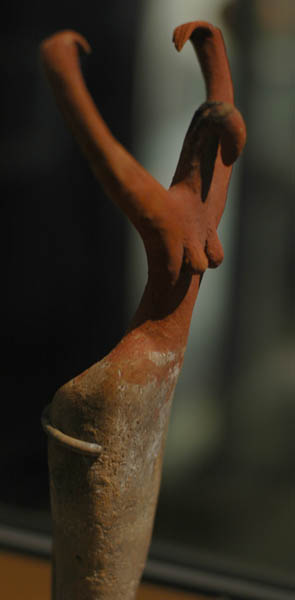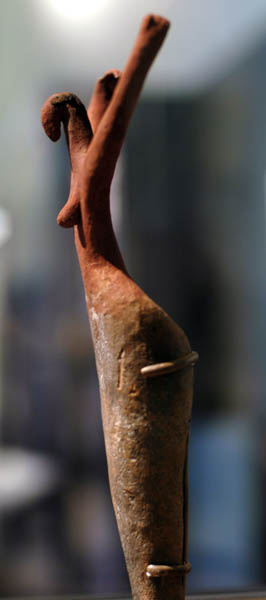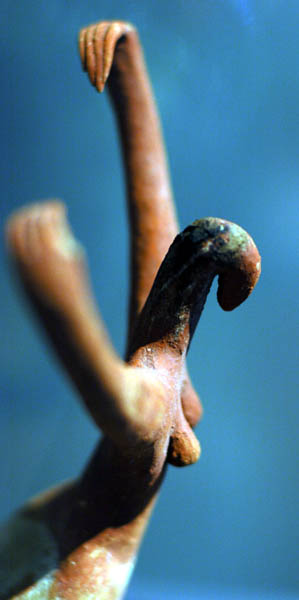- Bird Lady: Painted terracotta figurine of a woman
-
- The Brooklyn Museum of Art, between 1906 and 1908, sponsored an
expedition that excavated early sites in southern Egypt and brought back
many objects of historic and artistic value. This is one of the most
important and recognized of those. Dated to the Predynastic period,
Naqada IIa c.3500-3400 BC. Excavated by Henri de Morgan at the village
of Ma'mariya in 1907.
-
The earliest Egyptian art, created during the
pre-dynastic period (4400-3100 BC), exhibits a style that does not continue
into historical, dynastic times (after 3100 BC). All of this art comes from
graves that belonged to non-elite people. The objects created for these
tombs might be considered folk art. The earliest art is handcrafted pottery
with a surface ripple that potters created by running a comb over the
surface. This pottery was made during the Badarian period (4400-3800 BC),
named after the village of Badari where archaeologists first found it.
William Flinders Petrie discovered a nearly complete sequence of objects for
the subsequent period at the village of Nagada in southern (upper) Egypt.
Thus Egyptologists refer to the different chronological stages of this art
as Nagada I (3800-3500 BC), Nagada II (3500-3300 BC), and Nagada III
(3300-3100 BC). Nagada III overlaps with Dynasty 0 (3200-3100 BC), a newly
identified period when Egyptian kingship first appears. One very common
object of Nagada I is a ceramic jar or cup made from a red polished clay
with a black rim. Egyptologists call it black-topped red ware. The black
colour often extends to the middle of the jar. Potters built these jars by
hand with a coil of clay. The potter smoothed the coils once the pot was
built. The potter then fired the pot upside-down, producing the black rim.
These pots first appear in Nagada I and continue into Nagada II. The
emphasis on abstract decoration, though often beautiful, is not typical of
Egyptian art in the historical period after 3100 BC. This distinction,
however, cannot be used to argue convincingly that a different group of
people inhabited Egypt after the historical artistic style emerged.
-
Artists made some of the most interesting early figures
during Nagada II and III. Some figures were animal-shaped palettes
resembling fish, turtles, and birds. These were often made from schist, a
very commonly used stone in this period. Egyptians used these palettes to
grind galena, a naturally occurring mineral, into eye-liner called kohl.
Kohl both emphasized the eyes and possibly protected them from the glare of
the sun. The Egyptians also believed it protected the eyes from disease.
Some of the shapes of these palettes, such as the fish, represent symbols of
fertility and rebirth. The tilapia-fish, for example, carries its fertilized
eggs in its mouth. It thus appears that the offspring are born alive from
the mouth rather than hatched from eggs. The Egyptians thus included the
tilapia among their fertility symbols.
-
People in Nagada II and III also concerned themselves
with human figures. Among the first human figures were the female figurines
that the archaeologist Henri de Morgan discovered in the village of
Ma'mariya in 1907. Found in graves, her face appears beak-like. She wears
only a long white skirt that covers her legs completely. Her bare arms
extend upward in a graceful curving motion. Though these figurines are among
the most famous pre-historic sculptures from ancient Egypt, it is impossible
to determine with certainty whether the figure represents a priestess, a
mourner, or a dancer. Furthermore, it is completely unknowable whether she
is a goddess or a human. The generally abstract style used in this
sculpture, with each part of the body reduced to a simple organic outline,
does not continue into the historical period. Yet very similar female
figures occur painted on pottery contemporary with the figurines. The female
figures painted on pots are prominent in river scenes that include a boat
with two cabins, two male figures, and palm fronds on the shore. Some
examples depict mountains beyond the riverbank abstracted to triangles. The
female figure is the largest element in the composition, suggesting, as was
true in historic times, that she was the most important figure. The figures,
boat, palms, and mountains are in red paint on a light buff clay, typical of
the Nagada II period. Though the abstract style is not typical of the later
period, subject matter such as river scenes were popular throughout ancient
Egyptian history. If this is indeed a religious scene, it would be an early
example of a common Egyptian subject for art.
- Henri de Morgan, who died in 1909, was the
brother of Jacques Jean Marie de Morgan (Director General of the French
Service de Antiquities 1892-1897). Jacques trained Henri and used many
of the same techniques that provoked the scorn of Sir William Flinders
Petrie. Petrie did excavate a number of similar, but significantly less
quality, figures. He typically grouped these as "steatopygous figures."
-
- Note: from the above images that
the 'face' of the figurine shows clear bird like characteristics. The hands do
seem to be representing fingers.
-
| |





